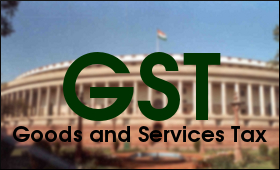|

|
GST Council has almost reached consensus on tax rates: FM
|
|

|
|
| Top Stories |
 |
|
|
|
SME Times News Bureau | 20 Oct, 2016
The GST Council has almost reached a consensus on compensating states for the revenue loss under the new revenue collection regime, which will facilitate a decision on the new tax structure at its next meeting, Union Finance Minister Arun Jaitley said on Wednesday.
"The Goods and Services Tax (GST) Council meeting today (Wednesday) discussed the issue relating to different rates of tax. Rates also depend on source of funds, on the basis of which compensation to losing states will be funded. Decision on a rate structure is possible once this is decided," Jaitley told reporters here after the meeting.
"We have virtually converged on a consensus. The technical issues will be sorted out and a formal decision announced at the next meeting," Jaitley, who chairs the GST Council, said.
"The question is whether the compensation will be funded from the rate structure itself, or some other sources, or some cess. Once this becomes clear, it will be possible to decide on the rate structure," he added.
The council's third meeting, that began on Tuesday, was cut short by a day.
Jaitley said the council will meet next on November 3-4, when the other major issue of "dual control", or the division of authority between the Centre and states, for tax assessments would also be decided.
"If these two issues (compensation funding and dual control) are settled, then a fifth meeting of the council on November 9-10 will take up the issue of draft legislations," Jaitley said.
Consensus on the matter of the funding mechanism for compensation payments by the Centre, thus, proved elusive in the third meeting of the GST Council, which was cut short by a day.
Kerala Finance Minister Thomas Isaac said the states could not agree on the four-slab structure proposed by the Centre.
Union Revenue Secretary Hasmukh Adhia said the issue of funding the compensation to the states will be discussed afresh in the November meeting.
Sources said the Centre's proposal of a cess, over and above the GST, on ultra-luxuries to fund the compensations, was not found acceptable by the states.
After the GST Council meeting on Tuesday, Adhia said the Centre has proposed a four-slab rate structure ranging from zero to 26 per cent.
The structure proposes GST at zero per cent on a variety of goods and services. On ultra-luxury items and "demerit" goods, such as big cars and tobacco products, it proposes cess over and above the 26 per cent GST rate.
On the remaining goods and services, the GST is proposed to be levied at 6 per cent, 12 per cent or 18 per cent.
"The proposal for determining the rate on each item is to levy and collect the GST at the rate slab closest to the current tax incidence on it," Jaitley said in response to a query on Wednesday.
The central government is following the roadmap to implement the GST by the targeted deadline of April 1, 2017.
The target rollout of GST will depend on the passage of the Central GST and the Integrated and GST (IGST) bills in parliament and the respective state GST bills by each state.
The GST is a single indirect tax that proposes to subsume most central and state taxes like the Value Added Tax, service tax, central sales tax, excise duty, additional customs duty and special additional customs duty.
The states will, however, be able to adopt a GST structure that is different from that recommended by the GST Council and the council recommendations will not be binding on the states.
Parliament and state assemblies have the right to accept those recommendations in their GST Bills.
Meanwhile, India Inc. has pitched for an 18 per cent standard rate on the ground that this rate will generate adequate tax buoyancy without fuelling inflation.
"The standard rate should be 18 per cent to avoid inflation, which can be reviewed after two years if it does not provide expected tax revenue," industry chamber Assocham said in a representation to the Revenue Secretary.
"To achieve the objective of a simple tax structure, and to avoid classification of disputes, GST should only be a two-rate structure," it added.
|
|
|
| |
|
|
|
|
|
|
|
|
|
|
|
|
|
|
| |
| Customs Exchange Rates |
| Currency |
Import |
Export |
US Dollar
|
66.20
|
64.50 |
UK Pound
|
87.50
|
84.65 |
Euro
|
78.25
|
75.65 |
| Japanese
Yen |
58.85 |
56.85 |
| As on 13 Aug, 2022 |
|
|
| Daily Poll |
 |
 |
| PM Modi's recent US visit to redefine India-US bilateral relations |
|
|
|
|
|
| Commented Stories |
 |
|
|
|
|
|
| |
|